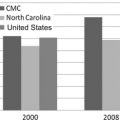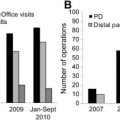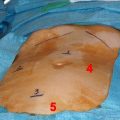The breast center concept developed in response to a fragmented inefficient system to evaluate and manage patients with diseases of the breast. The National Accreditation Program for Breast Centers (NAPBC) accreditation is granted only to those centers that have voluntarily committed to provide the best in the diagnosis and treatment of breast cancer and are able to comply with the established NAPBC standards. Each center must undergo a rigorous evaluation and review of its performance and compliance with the NAPBC standards. The NAPBC is in the process of defining the most efficient methods of data collection for the NAPBC-accredited programs.
The breast center concept developed in response to a fragmented inefficient system to evaluate and manage patients with diseases of the breast. Historically, patients with breast complaints or abnormal results of imaging studies had to find their way through a complex environment, waiting for long periods to get appointments and receive reports. Silverstein, some 4 decades ago, recognized these deficiencies and established the first free-standing breast center in the United States. This was to be the beginning of a major paradigm shift to address the needs of countless patients with benign and malignant diseases of the breast.
There is no reliable information about the number of breast centers, but one can estimate that the number is likely to be between 1300 and 1500. This estimate is based on the fact that the National Accreditation Program for Breast Centers (NAPBC) has received requests for information from more than 1400 parties. In addition, the Commission on Cancer (COC) of the American College of Surgeons (ACOS) currently accredits more than 1500 general cancer programs, and 98% of NAPBC-accredited breast centers and applicants are COC accredited.
Breast centers are not unique to the United States. For the past several years, European countries have developed multidisciplinary standards of care for patients with diseases of the breast and a survey process to monitor compliance with the standards. It is apparent that there is a growing global interest in organizing breast centers. The NAPBC has received inquiries from 20 countries around the world. The structure of a breast center would naturally depend on the resources, professional leadership, and government support in any particular country.
In the United States, the evaluation and management of patients with benign and malignant diseases of the breast are an enormous public health problem. It cannot be accommodated in a centralized, regional referral setting. Most care is delivered in a community setting. To assure the highest quality, there is a need for a multidisciplinary organized system with well-trained professionals. Fortunately, Disease of the breast disease is well taught in training programs, with many specialists possessing a major interest and experience in this field.
With this background, a need existed for assuring that these patients received well-organized competent care. The idea of an NAPBC to address this unmet need originated in the cancer programs at the ACOS. The Board of Regents of the college approved developmental funds in 2007. The college had experience and credibility in accrediting cancer, trauma, and bariatric centers; so it seemed natural to organize a breast center program. However, any new system proposal will, predictably, be met with some skepticism. The NAPBC strongly believed that this was the right thing to do and has prevailed.
A multidisciplinary Board of Directors, consisting of 32 members from 16 national organizations/societies, was organized and has continued to shape the NAPBC ( Box 1 ). The NAPBC Mission Statement states that “The NAPBC is a consortium of national, professional organizations dedicated to the improvement of the quality of care and monitoring of outcomes of patients with diseases of the breast. This mission is pursued through standard-setting, scientific validation and patient and professional education.”
American Board of Surgery
American Cancer Society
American College of Surgeons
American Society of Breast Disease
American Society of Breast Surgeons
American Society of Clinical Oncology
American Society of Plastic Surgeons
American Society for Radiation Oncology
Association of Cancer Executives
Association of Oncology Social Work
College of American Pathologists
National Cancer Registrars Association
National Consortium of Breast Centers
National Society of Genetic Counselors
Oncology Nursing Society
Society of Surgical Oncology
Members-at-Large
The NAPBC Board of Directors defined 17 essential components of evaluation and management every patient with disease of the breast should receive ( Box 2 ). To broaden the accessibility of patients to centers without compromising any step in the continuum, accredited centers may provide services on-site or refer to nearby locales for services they may not have, such as genetic counseling.
- 1.
Imaging
- 2.
Needle biopsy
- 3.
Pathology
- 4.
Interdisciplinary conference
- 5.
Patient navigation
- 6.
Genetic evaluation and management
- 7.
Surgical care
- 8.
Plastic surgery consultation/treatment
- 9.
Nursing
- 10.
Medical oncology consultation/treatment
- 11.
Radiation oncology consultation/treatment
- 12.
Data management
- 13.
Research
- 14.
Education, support, and rehabilitation
- 15.
Outreach and education
- 16.
Quality improvement
- 17.
Survivorship program
Stay updated, free articles. Join our Telegram channel

Full access? Get Clinical Tree






